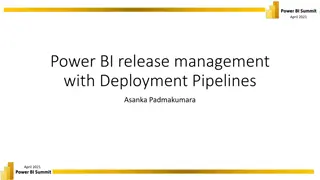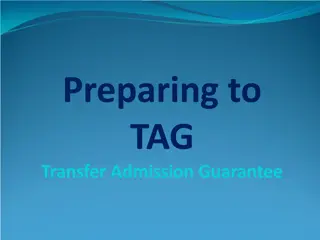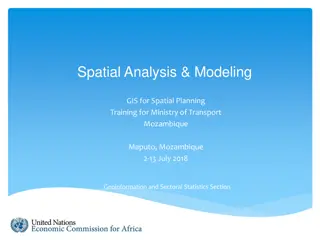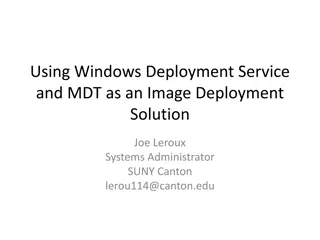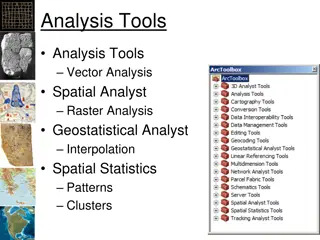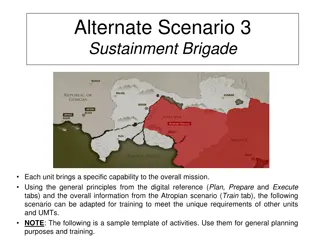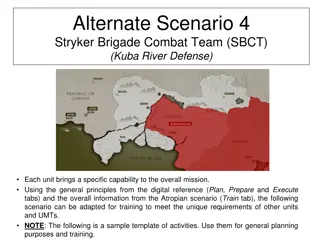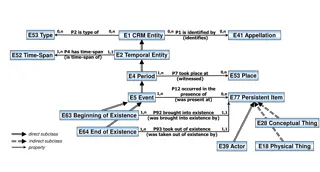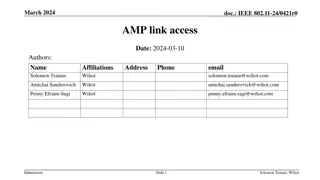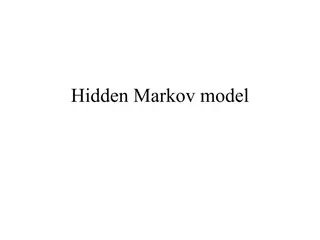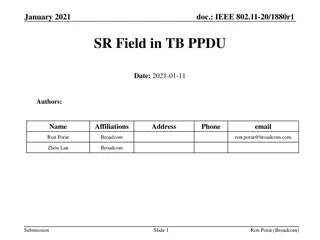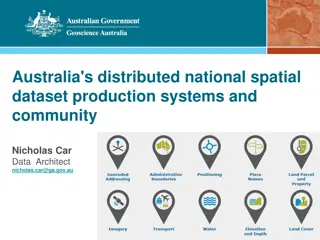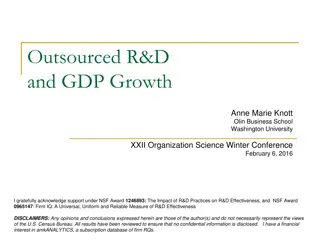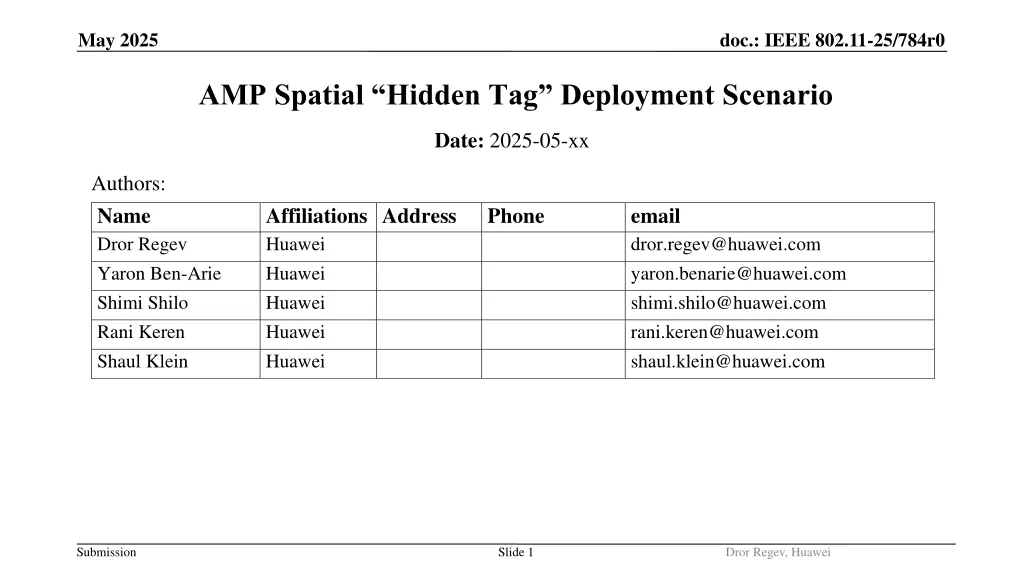
IEEE 802.11-25: AMP Spatial Hidden Tag Deployment Scenario Review
Explore potential spatial scenarios for active and bistatic BS AMP tags, discussing challenges in deployment locations and orientations. Learn about AMP tag range limitations, antenna gains, and spatial charging deployment scenarios for AMP active or enhanced BS tags.
Download Presentation

Please find below an Image/Link to download the presentation.
The content on the website is provided AS IS for your information and personal use only. It may not be sold, licensed, or shared on other websites without obtaining consent from the author. If you encounter any issues during the download, it is possible that the publisher has removed the file from their server.
You are allowed to download the files provided on this website for personal or commercial use, subject to the condition that they are used lawfully. All files are the property of their respective owners.
The content on the website is provided AS IS for your information and personal use only. It may not be sold, licensed, or shared on other websites without obtaining consent from the author.
E N D
Presentation Transcript
May 2025 doc.: IEEE 802.11-25/784r0 AMP Spatial Hidden Tag Deployment Scenario Date: 2025-05-xx Authors: Name Dror Regev Yaron Ben-Arie Shimi Shilo Rani Keren Shaul Klein Affiliations Address Huawei Huawei Huawei Huawei Huawei Phone email dror.regev@huawei.com yaron.benarie@huawei.com shimi.shilo@huawei.com rani.keren@huawei.com shaul.klein@huawei.com Dror Regev, Huawei Submission Slide 1
May 2025 doc.: IEEE 802.11-25/784r0 Abstract This discussion reviews potential spatial scenarios for active and bistatic BS AMP tags that may not be functional under potential AP-Energizer/Exciter deployment locations/orientations. Submission Slide 2 Dror Regev, Huawei
May 2025 doc.: IEEE 802.11-25/784r0 Background: AMP Tag Range Recap AMP tag harvesting & communicating are limited in terms of range Active tags support longer ranges, enabled by S1G wireless power transfer (WPT) and integrated high power transmitters. The AMP energizer may transmit from a different location/direction than the AP/receiver. The energizer signal and the AP signal arrive from different directions In [1], we proposed that AMP BS range can be extended utilizing tag gain, whereas WPT tag charging at S1G can support an adequate extended harvesting range as with active tags In bi-static BS the tag is excited from one direction and backscatters towards a different direction Submission Slide 3 Dror Regev, Huawei
May 2025 doc.: IEEE 802.11-25/784r0 Background: Antenna Gains Gain of antennas should be considered in AMP Antennas can be designed with directional gain that indicates how well they focus the signal in a specific direction, effectively achieving gain, as compared to an isotropic antenna that radiate/receive equally in all directions. Antenna gain is measured in decibels as compared with an isotropic antenna (dBi) Antenna gain is typically maximized in a direction perpendicular to the antenna surface. It is dependent on the spatial deviation angle, from this perpendicular line. + 6 dB + 3 dB 0 dB - 3 dB Antenna with Gain X 0 dBi Z Y Antenna with Gain Isotropic Antenna ? = ?( ??) Submission Slide 4 Dror Regev, Huawei
May 2025 doc.: IEEE 802.11-25/784r0 AMP Spatial Charging Deployment Scenario For AMP active or enhanced BS tags WPT charging, to the ith tag utilizing FRIIS model, is given by: Object Sensed with AMP Tags 2 (1) T2 T1 ??? ??? ??? ? ????= ??? 2 4?? Where: ????[?] is the power available for harvesting at the ith tag antenna output terminal ???[?] is the power fed into the energizing antenna input terminal ??? is the power gain of the ith tag antenna in the direction of the energizer ??? is the power gain of the energizer in the direction of the ith tag ??? [?] is the distance between the energizing and tag harvesting antennas ? [??] is the wireless energizing frequency ? [?/???] is the speed of light Energizer PTX ??? The figure shows that while tags T1 and T2 have very similar distances to the energizer, tag T1 have much higher antenna gain in the direction of the energizer (??1 ??2), which results in better WPT charging. Tag T2 may never charge if it has low ??2 antenna gain (depending on ???). Dror Regev, Huawei Submission Slide 5
May 2025 doc.: IEEE 802.11-25/784r0 AMP Bi-Static Backscattering Deployment Scenario For the carrier source signal arriving at the ith tag antenna and backscattering towards the AP, the respective power received at the AP is: ??? ??? ??? Where: ????[?] power arriving from the ith tag, at the AMP AP antenna output terminal ???[?] power of the carrier signal fed into the jth source antenna input terminal ??? is the power gain of the ith tag antenna at the direction of the AP ???? is the power gain of the AP antenna in the direction of the ith tag ????? is the tag backscattering magnitude (loss or gain) ??? [?] is the distance between the AP and the ith tag antennas AP 4 (2) ??? ???? ??? ? ????= ??? 2 ????? Object Sensed 2 T1 4?? T2 ???????? Carrier Source PTX ??? ??? The figure shows that while tag T1 has good antenna gain towards the carrier source, it has very low antenna gain in the direction of the AP (??1 ??1). Tag T2 on the contrary, has very low gain towards the carrier source and high gain in the direction of the AP (??2 ??2). Submission Slide 6 Dror Regev, Huawei
May 2025 doc.: IEEE 802.11-25/784r0 AMP Spatial Hidden Tag Deployment Scenario Assume an enhanced BS or active tag: AP Tag T1can possibly be charged by the energizer but may not be able to communicate with the AP Tag T2can communicate with the AP, yet cannot be charged/excited Therefore, both T1 and T2 can be viewed as inactive hidden tags Adding more energizers/exciters may activate T2 but T1 may always be inactive Positioning (location & orientation) of the AP may dictate hidden tag positions Object Sensed T2 T1 Energizer& Carrier Source Submission Slide 7 Dror Regev, Huawei
May 2025 doc.: IEEE 802.11-25/784r0 Hidden Active vs. Bistatic BS Tag Comparison We proposed to consider an enhanced extended range semi-active AMP tag with BS gain and WPT at S1G [1] as in active tags. Antenna gain in BS tags operating in a bi-static mode as well as in active tags, can enable extended EH range as well as communication range, yet likely create a trade-off between the two different ranges, since they have different gains and paths. Active tags are dependent on the exciters only for charging, but require longer charging durations to enable their higher power consumption AMP Tag Type Range Consumption 2.4 GHz modulated oscillator Enhanced BS Switch & Amplify UL power Power Storage / Capacitor Antenna Frequency UL Harvesting Active 10-50 M ~ 150 uW 2-5 C pF S1G & 2.4 GHz S1G (*) BS Semi-Active / ~ 10 M < 30-75 uW C pF S1G & 2.4 GHz S1G (*) * S1G is preferred for extended range/shorter duration EH. Harvesting at 2.4 GHz, may be used for backup Submission Slide 8 Dror Regev, Huawei
May 2025 doc.: IEEE 802.11-25/784r0 Hidden Active vs. Bistatic BS Tag Further Comparison Energizer / Carrier Source AMP Tag i ??? ??? ??? ??? Assume the AMP tag has a sufficient EH/exciter gain with ??? ???>>1 and the tag can be charged. ??? If the tag-AP path has low gain, ??? ????<<1, both active and BS tags will experience similar communication constraints. ???? AP Therefore, the hidden tag likelihood for both active and BS tags may be similar. Submission Slide 9 Dror Regev, Huawei
May 2025 doc.: IEEE 802.11-25/784r0 Hidden Tags Discussion: Most earlier discussions overlooked AP, energizer/exciter and especially tag antenna directivity effects Assuming a single AP, in a non-monostatic deployment, it is likely that some AMP tags will not be functional, especially when considering extended range scenarios. The likelihood to have hidden tags can be reduced by deployments of multiple energizer/exciter devices, yet it can not be eliminated Submission Slide 10 Slide 10 Dror Regev, Huawei
May 2025 doc.: IEEE 802.11-25/784r0 Summary AMP tags, except monostatic BS, can be hidden from the AP, the energizer/exciter or even both. The likelihood to result in such dormant tags depends on the space scenario, EH and communication operation ranges considered and the directivity and orientation of the respective antennas. Such AMP hidden tags should be considered Future work will focus on approaches for reducing the likelihood of AMP hidden tags Submission Slide 11 Slide 11 Dror Regev, Huawei
May 2025 doc.: IEEE 802.11-25/784r0 References 1. 11-25-0307r0 UL Monostatic and Bistatic Range Extension Considerations ; Dror Regev (Huawei) Submission Slide 12 Slide 12 Dror Regev, Huawei


